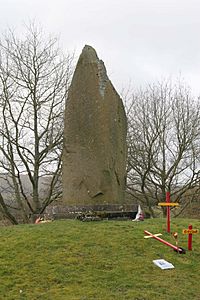Battle of Orewin Bridge facts for kids
Quick facts for kids Battle of Orewin Bridge |
|||||||
|---|---|---|---|---|---|---|---|
 The Llywelyn Monument at Cilmeri which marks the battle of Orewin Bridge |
|||||||
|
|||||||
| Belligerents | |||||||
| Kingdom of England Supported by: Powys Wenwynwyn |
Principality of Wales | ||||||
| Commanders and leaders | |||||||
| Roger l'Estrange John Giffard Edmund Mortimer Gruffydd ap Gwenwynwyn Owen de la Pole |
Llywelyn ap Gruffudd † | ||||||
| Strength | |||||||
| 5,000 Infantry 1,300 Heavy Cavalry |
7,000 Infantry 160 'Teulu' (Household) |
||||||
| Casualties and losses | |||||||
| Unknown | Around 2,000 | ||||||
The Battle of Orewin Bridge, also called the Battle of Irfon Bridge, was a big fight between the English and Welsh armies. It happened on December 11, 1282, near a place called Builth Wells in central Wales. This battle was a huge loss for the Welsh because their leader, Llywelyn ap Gruffudd, was killed. This event basically ended Wales's independence at that time.
Contents
Why the War Started
This battle was part of a bigger war. The Welsh leader, Llywelyn, had already fought against Edward I of England in 1277. King Edward had a very strong army. He took over much of North Wales, reaching the Conwy River. He also used ships to capture Anglesey, which was important for Welsh food supplies.
Llywelyn was forced to agree to harsh terms. He had to give up large parts of Wales to England. For the next five years, there was a lot of tension. Llywelyn and Edward had disagreements. Also, the Welsh people were unhappy with their new English rulers.
The fighting started again in 1282. Llywelyn's brother, Dafydd ap Gruffydd, began the revolt. Dafydd had actually sided with King Edward earlier. But now, he captured Hawarden Castle and defeated its soldiers. After this, many parts of Wales rose up. Llywelyn then declared war on Edward for all of Wales.
The Fight Before December
King Edward used the same plan as in the earlier war. He slowly took control of North Wales. He also occupied Anglesey again. At the same time, he sent armies into southern and central Wales. These armies tried to control Llywelyn's friends and possible supporters.
However, the Welsh had some successes. At the Battle of Llandeilo Fawr, the English army attacking South Wales was surprised and defeated. Later, on November 6, Edward's commander in Anglesey, Luke de Tany, attacked too early. He tried to cross the Menai Strait using a bridge made of boats. His force was trapped and defeated at the Battle of Moel-y-don.
These unexpected defeats slowed King Edward down. He had to stop and gather new armies and supplies. Llywelyn used this time to travel into central Wales. He wanted to encourage and gather support there. This area was ruled by powerful Marcher Lords. Some of them were thinking about supporting Llywelyn.
But three Marcher Lords stayed loyal to Edward. They were Roger l'Estrange, John Giffard, and Edmund Mortimer. They had an army in central Wales. This army included archers from Shropshire and some heavy cavalry. They also had soldiers from a Welsh lord named Gruffydd ap Gwenwynwyn. He was an old enemy of Llywelyn. The English army had about 5,000 foot soldiers and 1,300 heavy cavalry.
The Battle of Orewin Bridge
On December 11, Llywelyn's army was on a hillside. It was north of the Irfon River, near the village of Cilmeri. They were ready to stop any attack from the south, across Orewin Bridge. The Welsh army had thousands of spearmen and javelin throwers from North Wales. They also had some of Llywelyn's own special household guards, called teulu. There were also some archers from Brecon. These archers had joined Llywelyn after the English lost at Llandeilo Fawr. In total, the Welsh army had about 7,000 foot soldiers and 160 cavalry.
Llywelyn himself was not with his army at first. He had gone to talk with local leaders, possibly at Builth Castle.
A local person told the Marcher Lords about a place to cross the Irfon River. It was a ford, about two miles downstream. The Marchers sent most of their archers across this ford. They planned to attack the Welsh from the side. The Welsh army turned to face these archers. This left the Orewin Bridge unguarded. The English mounted knights then charged across the bridge.
Meanwhile, the English archers shot arrows into the Welsh spear formations. This made the Welsh soldiers weaker and disorganized. Then, the English heavy cavalry attacked the back of the Welsh army. The Welsh soldiers were without their leader and lost hope. They were completely defeated and ran away.
As the Welsh army fled, Llywelyn quickly returned. On the edge of the battle, an English soldier attacked him. This soldier was named Stephen de Frankton. Llywelyn was killed.
What Happened Next
Llywelyn's body was not recognized until the next day. He probably went to his meeting secretly. So, he would not have worn any special clothes or symbols. His head was cut off and taken to London to be shown. Llywelyn left behind only a baby daughter, Gwenllian of Wales.
Leadership of the Welsh then went to Dafydd, Llywelyn's brother. He led a hidden resistance for a few months. But he was soon betrayed, captured, and executed. King Edward was then able to officially end the organized Welsh resistance.
Sources
- Famous Welsh Battles, Philip Warner, Fontana, 1977, ISBN: 0-00-634151-9

